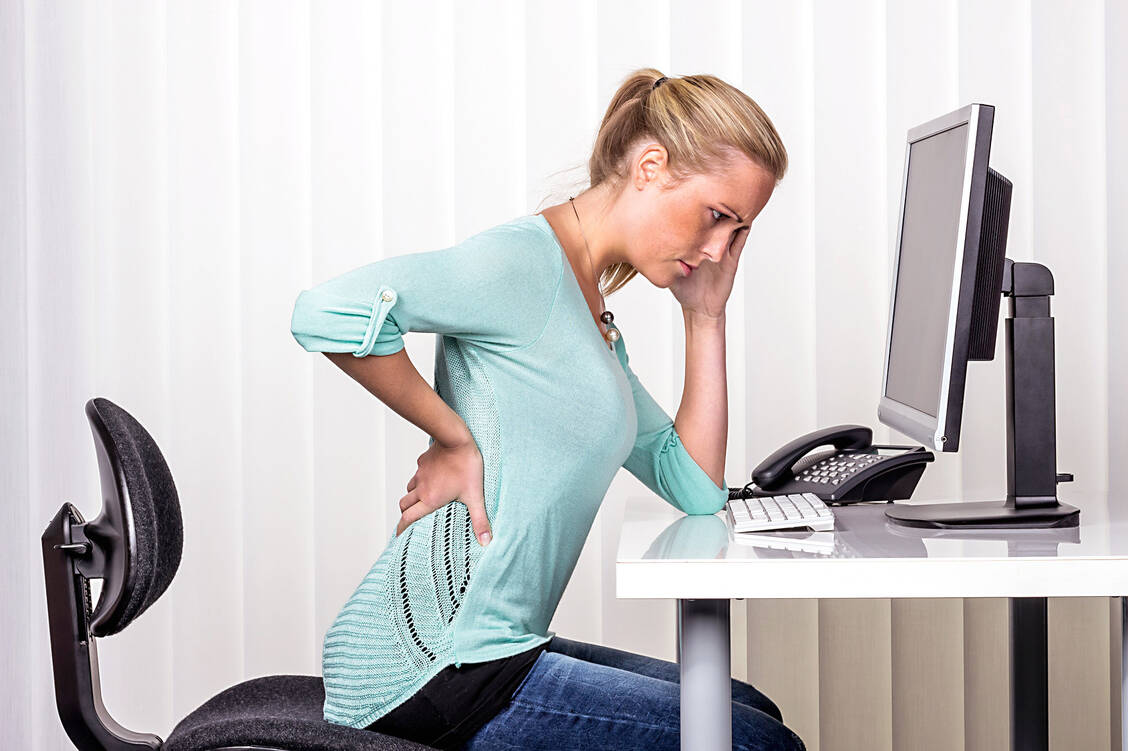
Weitere Angebote der PZ

© 2025 Avoxa - Mediengruppe Deutscher Apotheker GmbH
Taking the pain away |

Most backache is uncomplicated and can be managed through exercise, medical education and appropriate drug therapy. / Foto: Fotolia/Gina Sanders
In many cases, the modern, mainly sedentary lifestyle is the cause for the pain in the back. Many people spend much of the day in a sitting position, be it in the car, at a desk or relaxing on the couch in the evening. Constant physical and mental strain, non-ergonomic seating, obesity, lack of muscle strength or even draughts can also trigger backache. For many people with chronic complaints, several causes act together. To make the pain more bearable, many sufferers adopt relieving postures that are unnatural and affect other structures. In the end, this only intensifies the complaints.
Most backache is uncomplicated and can be managed through exercise, medical education and appropriate drug therapy. Self-medication focuses on the short-term use of painkillers. They make it possible to remain as active as possible in everyday life and to continue pursuing a professional activity. However, painkillers have a purely symptomatic effect. They only relieve the pain, but do not fight the cause of the backache. The drugs of choice in the acute stage are non-steroidal anti-inflammatory drugs (NSAIDs) in oral form, such as ibuprofen and diclofenac.
The potential of orally administered NSAIDs to relieve pain and improve function in the short term has been demonstrated in several reviews. The individual NSAIDs do not differ significantly in effectiveness. However, the chosen NSAID should be dosed as low as possible. According to the guideline, this means a maximum daily dose of up to 1.2 g ibuprofen, 100 mg diclofenac or 750 mg naproxen. If patients do not experience sufficient improvement, they can increase the dose briefly to up to 2.4 g ibuprofen, 150 mg diclofenac or 1.25 g naproxen. Side effects may include gastrointestinal discomfort (nausea, heartburn, stomach pain, gastrointestinal ulcers), headache, dizziness, decreased urine output, oedema and high blood pressure. If there is a particular risk of gastrointestinal complications, a proton pump inhibitor may be useful as a prophylactic measure.
Paracetamol, which is usually given for pain, is hardly effective for non-specific low backache. In current studies, neither pain nor functional capacity could be improved. In exceptional cases, however, the drug in a maximum daily dose of 3 g may be worth a try.
Pain ointments with NSAIDs are also popular in self-medication. However, there is a lack of sufficient evidence from studies for the use of topically applicable NSAIDs for non-specific low backache. Nevertheless, many patients find preparations with diclofenac or ibuprofen pleasant. The side effects to be expected are limited compared to oral application. What may occur are local hypersensitivity reactions such as itching, redness, rash or burning of the skin. An alternative to rub-in preparations are pain plasters.
Some patients specifically ask for something herbal. For problems of the bone and joint system, preparations with arnica, salicylates or comfrey root extract are tried and tested. For internal use, the guideline authors recommend primarily willow bark preparations. Hyperaemic essential oils such as lavender, rosemary or mint may improve the symptoms of pain sufferers by means of their local massage effect. Side effects include especially hypersensitivity reactions, reddening of the skin and swelling.
Muscle tension, which is often at the root of backache, can be relieved with heat applications. Heat relaxes, promotes blood circulation and relieves pain. At home, patients can use the classic hot water bottle, a grain pillow or an electric blanket. If you are on the road or want to be physically active also during treatment, you can use ointments that promote blood circulation or heat patches or compresses with capsaicin or cayenne pepper extract, nonivamide or nicoboxil. You must not use more than one heat patch per day, as this increases the risk of skin irritation or burns. It should be placed on dry, intact skin and remain there for four to twelve hours. As long as the plaster is there, no other externals should be applied, and patients should also refrain from additional heat applications. After that, a twelve-hour break is needed until the next heat patch is applied.
| Deutsch/German | Englisch/English |
|---|---|
| Cayennepfeffer | Cayenne pepper |
| Durchblutung | blood circulation |
| Externa | externals |
| Kreuzschmerzen | backache |
| Lavendel | lavender |
| Magenschmerzen | stomach pain |
| Minze | mint |
| Muskelkraft | muscle strength |
| Muskulatur | muscles |
| Pflaster | patch, plaster |
| Rosmarin | rosemary |
| Rückenschmerzen | backache |
| Schmerzen | pain, ache |
| Schonhaltung | relieving posture |
| Sodbrennen | heartburn |
| Wärmepflaster | heat patch |
| Wärmflasche | hot-water bottle |
| Weidenrinde | willow bark |